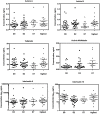Serum activin A and B, and follistatin in critically ill patients with influenza A(H1N1) infection
- PMID: 24885241
- PMCID: PMC4101860
- DOI: 10.1186/1471-2334-14-253
Serum activin A and B, and follistatin in critically ill patients with influenza A(H1N1) infection
Abstract
Background: Activin A and its binding protein follistatin (FS) are increased in inflammatory disorders and sepsis. Overexpression of activin A in the lung causes similar histopathological changes as acute respiratory distress syndrome (ARDS). ARDS and severe respiratory failure are complications of influenza A(H1N1) infection. Interleukin 6 (IL-6), which in experimental studies increases after activin A release, is known to be related to the severity of H1N1 infection. Our aim was to evaluate the levels of activin A, activin B, FS, IL-6 and IL-10 and their association with the severity of respiratory failure in critically ill H1N1 patients.
Methods: A substudy of a prospective, observational cohort of H1N1 patients in Finnish intensive care units (ICU). Clinical information was recorded during ICU treatment, and serum activin A, activin B, FS, IL-6 and IL-10 were measured at admission to ICU and on days 2 and 7.
Results: Blood samples from 29 patients were analysed. At the time of admission to intensive care unit, elevated serum levels above the normal range for respective age group and sex were observed in 44% for activin A, 57% for activin B, and 39% for FS. In 13 of the 29 patients, serial samples at all time points were available and in these the highest activin A, activin B and FS were above the normal range in 85%, 100% and 46% of the patients, respectively. No difference in baseline or highest activin A or activin B was found in patients with or without acute lung injury (ALI) or ARDS (P > 0.05 for all). Peak levels of IL-6 were significantly elevated in ALI/ARDS patients. Peak activin A and activin A/FS were associated with ventilatory support free-days, severity of acute illness and length of ICU stay (P < 0.05 for all).
Conclusions: Higher than normal values of these proteins were common in patients with H1N1 infection but we found no association with the severity of their respiratory failure.
Figures



Similar articles
-
Heparin-binding protein (HBP) in critically ill patients with influenza A(H1N1) infection.Clin Microbiol Infect. 2013 Dec;19(12):1122-8. doi: 10.1111/1469-0691.12156. Epub 2013 Feb 12. Clin Microbiol Infect. 2013. PMID: 23402373
-
Prospective Observational Study on the Association Between Serum Mannose-Binding Lectin Levels and Severe Outcome in Critically Ill Patients with Pandemic Influenza Type A (H1N1) Infection.Lung. 2018 Feb;196(1):65-72. doi: 10.1007/s00408-017-0067-5. Epub 2017 Dec 22. Lung. 2018. PMID: 29273833 Free PMC article.
-
Influenza-induced acute respiratory distress syndrome during the 2010-2016 seasons: bacterial co-infections and outcomes by virus type and subtype.Clin Microbiol Infect. 2020 Jul;26(7):947.e1-947.e4. doi: 10.1016/j.cmi.2020.03.010. Epub 2020 Mar 20. Clin Microbiol Infect. 2020. PMID: 32205296
-
Critically ill patients with 2009 influenza A(H1N1) infection in Canada.JAMA. 2009 Nov 4;302(17):1872-9. doi: 10.1001/jama.2009.1496. Epub 2009 Oct 12. JAMA. 2009. PMID: 19822627
-
[ARDS and influenza A (H1N1): patients' characteristics and management in intensive care unit. A literature review].Ann Fr Anesth Reanim. 2010 Feb;29(2):117-25. doi: 10.1016/j.annfar.2009.12.026. Epub 2010 Feb 8. Ann Fr Anesth Reanim. 2010. PMID: 20116970 Review. French.
Cited by
-
Activin Biology After Lung Transplantation.Transplant Direct. 2017 May 11;3(6):e159. doi: 10.1097/TXD.0000000000000676. eCollection 2017 Jun. Transplant Direct. 2017. PMID: 28620643 Free PMC article.
-
Diagnosis of parapneumonic pleural effusion with serum and pleural fluid Activin A.Clinics (Sao Paulo). 2022 Nov 11;77:100133. doi: 10.1016/j.clinsp.2022.100133. eCollection 2022. Clinics (Sao Paulo). 2022. PMID: 36375297 Free PMC article.
-
Transforming Growth Factor β Superfamily Signaling in Development of Colorectal Cancer.Gastroenterology. 2017 Jan;152(1):36-52. doi: 10.1053/j.gastro.2016.10.015. Epub 2016 Oct 20. Gastroenterology. 2017. PMID: 27773809 Free PMC article. Review.
-
Neutrophil-derived Activin-A moderates their pro-NETotic activity and attenuates collateral tissue damage caused by Influenza A virus infection.Front Immunol. 2024 Feb 26;15:1302489. doi: 10.3389/fimmu.2024.1302489. eCollection 2024. Front Immunol. 2024. PMID: 38476229 Free PMC article.
-
Activin A Modulates Inflammation in Acute Pancreatitis and Strongly Predicts Severe Disease Independent of Body Mass Index.Clin Transl Gastroenterol. 2020 May;11(5):e00152. doi: 10.14309/ctg.0000000000000152. Clin Transl Gastroenterol. 2020. PMID: 32358238 Free PMC article.
References
-
- Jones KL, Mansell A, Patella S, Scott BJ, Hedger MP, de Kretser DM, Phillips DJ. Activin A is a critical component of the inflammatory response, and its binding protein, follistatin, reduces mortality in endotoxemia. Proc Natl Acad Sci U S A. 2007;14:16239–16244. doi: 10.1073/pnas.0705971104. - DOI - PMC - PubMed
Publication types
MeSH terms
Substances
LinkOut - more resources
Full Text Sources
Other Literature Sources
Medical
Molecular Biology Databases

